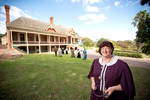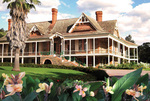History repeats at Urrbrae House
Peter Waite decided to bequeath the historic Urrbrae House and estate to the University of Adelaide 100 years ago in an extraordinary act of generosity. His legacy created one of Australia's most celebrated agricultural science research and teaching centres which is now undergoing a $50 million expansion thanks to support from other benefactors. In 1913 Peter Waite had a vision of creating a research and education centre in agricultural sciences for the long-term benefit of Australian farmers. The Scottish migrant had carved a fortune out of the land as a pastoralist after arriving in South Australia in 1859 when he was 25. But by 1913 he felt Australian agriculture was stagnating and would struggle to remain internationally competitive without scientific input. With the support of his wife Matilda and children, he decided to leave his impressive mansion Urrbrae House and farming estate to the University of Adelaide for the creation of an agricultural sciences campus. Fearing that the 53 hectare estate might not be large enough, he more than doubled the size of his bequest by purchasing an additional 66 hectares of land from the adjoining Claremont and Netherby estates. For someone who had never attended university, it was an inspiring move. But Peter was a keen innovator and he loved science. A trained ironmonger, he succeeded as a farmer by leading in areas such as land rotation, fencing, building dams and vermin eradication. He personally indulged his love of new technology by having the second registered automobile in South Australia and equipping Urrbrae House with Australia's first domestic refrigeration plant. The two-storey bluestone mansion was completed by the Waites in 1891 on the site of a single-storey house built by another Scotsman, Robert Macgeorge, who named the estate after his former parish 'Urr' and 'brae', which denotes a hillside near a creek. The estate was handed over to the University in 1923, the year after Peter and Matilda Waite died. Turning what was essentially sheep paddocks into a centre of agricultural science then fell to inaugural Director Professor Arnold Richardson, a charismatic local cereal breeder, who worked in close partnership with accomplished English soil scientist Professor James Prescott. The new campus was named the Waite Agricultural Research Institute (WARI) and modelled on the successful Rothamsted Experimental Station in England. "Peter demonstrated incredible foresight in so many ways, including his stipulation that part of the estate be protected for public recreation which today is the Waite Arboretum," said Urrbrae House Manager and historian Lynette Zeitz. "He was also spot on with the amount of land the University would need for the campus with new buildings still being added." Ms Zeitz has written a new history of the Waite Campus since 1975 following on from VA Edgeloe's book, The Waite Agricultural Research Institute: The First Fifty Years 1924-1974. The new book will be published at the end of the year. Today the Waite Campus is a thriving centre of agricultural research and education excellence and Urrbrae House stands on the edge of the campus as a lasting symbol of Peter Waite's vision. For the first 50 years as part of the University the house was home to the Waite Institute directors. In the 1960s the ballroom became a student refectory and the dining room was used by staff. Today Urrbrae House is an accredited museum open to the public three days a week. Ms Zeitz runs the building as an education, cultural and conference centre for the benefit of the campus, community and schools. Each year up to 800 primary school children take part in a free interactive history program at the house which allows them to experience life in the 1890s. The program operates with the help of volunteers who recreate characters such as Peter and Matilda Waite, and their household staff. In a separate 'Plants as Food' program run with the Office for Future Students, children learn about being plant scientists in the past and see the amazing new technologies being used on the campus today. The campus itself has also evolved and grown significantly. In 1991 the University of Adelaide, including the Waite Campus, merged with Roseworthy Agricultural College and the following year a co-location agreement between the University, State Government and CSIRO revitalised the campus and resulted in agricultural scientists from different institutions working side by side. What hasn't changed over the years is the influence and key role played by benefactors. Peter Waite proved an inspiration for generations of others, including his daughters, Lily and Eva, who funded the University of Adelaide footbridge over the River Torrens. In the 1920s John Melrose and the family of John Darling made substantial donations to create new laboratory buildings at Waite Campus, and in March this year the University announced its biggest ever investment at the Waite and Roseworthy Campuses using $50 million in funds from gifts by JAT Mortlock and JS Davies. "Not since Peter Waite a century ago have we seen an investment even close to this magnitude for agricultural science research in this country," said Vice-Chancellor and President Professor Warren Bebbington. "These initiatives will make a major contribution to international research in agriculture and animal production, and confirm Adelaide as the leading centre for animal and agricultural research in Australia. "I'm certain Peter Waite would approve." KEY DATES
1834 - Peter Waite born in Kirkcaldy, Scotland
1859 - Joins his brother James in South Australia
1877 - Peter and his family move into the old Urrbrae House
1891 - The new Urrbrae House is completed
1913 - Peter indicates his intention to leave his estate to the University of Adelaide and land to the State Government for the creation of an agricultural high school
1915 - Purchases land in adjoining Claremont and Netherby estates for the University
1922 - Peter and Matilda Waite die aged 88 and 86 respectively
1923 - Daughters Lily and Eva Waite hand over the estate to the University of Adelaide
1924 - Waite Agricultural Research Institute created
1932 - Urrbrae Agricultural High School created
1955 - Australian Wine Research Institute established at the Waite
1991 - Urrbrae House opened to the public
1992 - Co-location agreement between the University, State Government and CSIRO
2013 - $50 million investment in Waite and Roseworthy campuses
|







